�

�
(Photograph courtesy of Sean S. Smith Photography.)
�
Walt Hansgen's Jaguar XK120 Special, now raced by Bob Millstein
� � Owner: Bob Millstein� City: Briarcliff Manor, New York
� Model: 1951 XK120 Special
� Engine: Jaguar 3.5L six cylinder
� Originally built by: Walt Hansgen
� Race prepared by: Briarcliff Classic and Imported Car Service�
�
The Car that Launched Walt Hansgen's Racing Career
��
Walter E. Hansgen was born on October 28, 1919 and grew up in a northern New Jersey�
small town. He worked in his family's automotive body shop until the age of 32, when�
bitten hard by the racing bug he scraped and borrowed to purchase a 1951 XK120�
brand new from the Jaguar dealer in Morristown. He entered the Jaguar in several races�
(including the 1951 Watkins Glen Grand Prix) but found it wasn't competitive enough�
to keep pace with his rapidly improving talents or with the Allards, Cunninghams, and�
Ferraris of the day.�
�
In fact, the three results I found for Walt Hansgen in 1952 season SCCA National races were�
all logged in borrowed cars. On March 15, Hansgen shared an MG TD with Randy Pearsall�
to finish 10th overall at Sebring (666 miles in 12 hours). At Bridgehampton (on Long�
Island) on May 24 Hansgen borrowed Don McKnought's modified 1952 Jaguar XK120 coupe �
to take second overall and first in Class 3 in the 10-lap Hayground Cup race. For the�
Grand Island Grand Prix of August 30, 2952 Hansgen borrowed a Siata Gran Sport to take�
a second place finish in the under-1500cc race. Hansgen would need a much faster car�
to compete with the Jaguar C-Types which made their North American debut spectacularly�
at Elkhart Lake in September 1952.�
�
Unable to purchase a C-Type for the 1953 season, Hansgen decided to transfer his Jaguar�
XK120's key components to a lightweight "special". By replacing the XK120's basically�
two-dimensional ladder frame with an elaborate three-dimensional structure of (mostly)�
round tubing, he hoped to meet or beat the C-type's 2100 pound curb weight. Combined with�
a lightweight body and eliminated trim, this would amount to over 700 pounds of weight�
reduction compared to an un-modified XK120 roadster.�
�
�
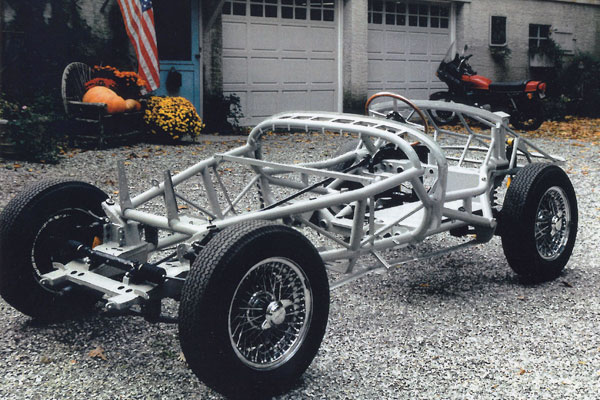
�
Walt Hansgen and Emil E. Hoffman built this multi-tube frame mainly of 8 gage (i.e. 0.165" wall
�
thickness) chrome-moly steel tubing. Chrome-moly is a high tensile alloy that Hoffman was familiar
�
with from his service in aviation factories during World War II, but for most car builders it would
�
remain an esoteric material for several more decades. (Photograph courtesy of Bob Millstein.)
�
Please support the sponsoring companies who make www.BritishRaceCar.com possible, including:
� �
 �
�
�
�
�
The F.G. Hansgen auto-body shop in Westfield, New Jersey was home base for all this work,�
and in it Walt Hansgen had access to all the tools, machinery, and skilled help he needed.�
Emil Hoffman did much of the panel beating and probably all of the oxy-acetylene welding�
on the aluminum body. Hansgen's father helped prepare the body, and Jimmy Brown laid down�
the original paint job.�
�
Hansgen probably first raced his Jaguar special at Cumberland Maryland in early May 1953.¹�
(This was an SCCA regional race.) As recorded in The Washington Daily News:�
"The big race was a thriller and the spectators�
who lined the hills surrounding the airport watched Walter Hansgen in a Jaguar Special and�
J.L. Negley in a Chrysler-powered Allard LeMans battle neck and neck for 32 laps. On the�
24th lap, Hansgen sliced into the lead on a turn only to lose it again a couple of laps�
later. Then on the 31st lap, Hansgen sneaked inside to get on top again on one of those�
acute turns. Negley went all out to get a shade in front on the next straightaway and�
plunged into the backstretch S turn at a roaring 80 miles an hour. His white No. 11 Allard�
spun around and smacked one of the guarding hay bales. The bump pushed his left front�
fender into his tire and he limped back to the pits, so it was a cinch for Hansgen, who�
had only to keep out of trouble the rest of the way to win."�
�
Hansgen also raced his special on the streets and roads of Bridgehampton on May 23rd. David Leigh�
described the Hansgen Special in his race report: "The Bridgehampton Cup race brought out Walt�
Hansgen's beautiful tubular-chassis Jaguar special with a total weight, including Walter,�
of just over 2100 pounds. Walt designed and built the car himself, taking 14 months in�
the process, and it can be described as a masterpiece. Walt gave the impression that he�
was driving the car easily and was running between the XK-Cs of Harry Grey and Henry Wessels�
at the time the race was stopped although he had previously passed both cars with apparent�
ease. Strange though was the fact that none of the three cars was lapping faster than�
Hansgen did last year in Don McKnought's modified XK coupe." Unfortunately, the�
Bridgehampton Cup race was black-flagged early on account of an accident involving�
three spectators.�
�
�

�
Jaguar Cars Ltd., Coventry, England.
�
Chassis No. 670835 - Engine No. W2222-8 - Body No. F2061 - Gearbox No. JH4485
�
�
The Hansgen Special raced again on July 19 at Cumberland Maryland, and came home with the�
biggest trophy: Hansgen defeated a string of XK120s to finish first in the sixty lap�
Cumberland Cup race. (J.L. Negley's Allard had been faster earlier in the day, in the�
over-1500cc sprint race.)�
�
At Floyd Bennett Field on August 29 Hansgen entered his Jaguar special in a 215-mile�
endurance race, but reportedly most of the driving responsibilities that day were handled�
by friend and co-driver William Eager. As a team they finished fifth overall and second in class.�
The records show 41 starters and that the cars finishing faster were two Cunninghams�
(both in the B-Modified class) and two Ferraris (one in C-Modified.) Incidentally, Hansgen�
and Eager later shared an OSCA for the 1955 Sebring 12 hour race.�
�
�
IMPORTANT ANNOUNCEMENT
�
BritishRaceCar.com will have to cut back plans for continued growth if we can't find more financial support.
�
If you like what you've found here, and you want to see more, please click here and follow the instructions.
�
Readers like you keep BritishRaceCar.com online and growing through voluntary financial contributions.
�
�
At Thompson in Connecticut on September 6, Hansgen took second place behind Masten Gregory's C-Type.�
�
The most important race of Hansgen's season was held on September 19. Hansgen proved his engineering�
ability and his driving at the Watkins Glen Grand Prix where he edged out George Harris's Allard�
on the final lap. The Washington Daily News provided this play-by-play coverage:�
"Hansgen set the pace for 18 laps of the 22-lap race before Harris slid by him on the�
19th. Hansgen regained the lead on the next round only to lose it again on the 21st.�
Harris takes the curve on the inside. Hansgen won't be denied. He takes to the dirt and�
gravel along the outside. Hansgen's wheel throws a storm of gravel and the engine's�
thunder strangles momentarily as the Jaguar goes around crabwise. He gives it the gun,�
fishtails, then zooms past Harris and crosses the finish line - the winner!"�
�
After the 1953 season, Hansgen sold his XK120 Special to a friend (Paul Timmins) and�
then purchased Masten Gregory's Jaguar C-Type to continue his career with.�
Hansgen continued as a privateer until Briggs Cunningham recruited him, and then his�
professional racing career really took off. Hansgen won SCCA's C-modified National�
Championship four years in a row driving Jaguar-powered cars. For Cunningham he drove�
D-Types, Lister-Jaguars, and lightweight E-Types. In 1960, he piloted the prototype�
Jaguar E2A racer at Le Mans, co-driving with Dan Gurney. Hansgen also showed his versatility�
by successfully driving open-wheeled racecars including particularly Cooper Formula Juniors�
and Lotus Formula One cars. In 1964 he qualified 10th for the Indy 500 in the MG�
"Liquid Suspension Special" and then ran as high as second place in the race until�
mechanical problems. Hansgen died on April 7, 1966 from injuries suffered while testing�
a Ford GT40 in preparation for the 24 Hours of Le Mans.�
�
Paul Timmins had one successful season with the Hansgen Special before dying in a road�
accident in March 1955. The car passed to George Sterner of York, Pennsylvania who kept�
it registered as a road car until selling it to Ed Jurist of The Vintage Car Store in�
June 1966. Jurist's dealership then sold the car to J.D. Inglehart of Connecticut who�
occasionally entered it in hillclimbs. Current owner Bob Millstein was impressed by�
the Hansgen Special when he saw Inglehart driving it at the Mt. Equinox hillclimb in�
1979.�
�
�
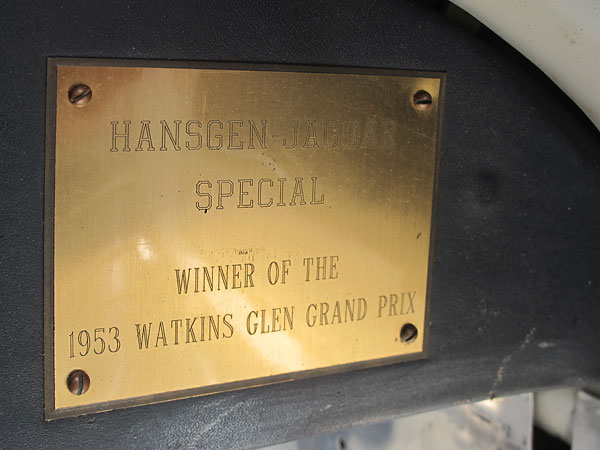
�
HANSGEN-JAGUAR SPECIAL
�
WINNER OF THE 1953 WATKINS GLEN GRAND PRIX
�
Bob Millstein's Stewardship
��
Bob Millstein bought the Hansgen Special in 1983. Back home at his shop, Briarcliff�
Classic and Imported Car Service in Westchester County (north of New York City),�
he carefully removed the body and started a comprehensive restoration. In this he�
was assisted by Michael Gregory, Leo Bunker, and Ed Willimann. The Hansgen Special's�
one-of-a-kind handcrafted aluminum body required the highly specialized attention of�
Romeo Autobody in Brooklyn. Finally, in 1989 it all came back together and was ready�
for public display. In fact, the restored Hansgen Special was the Jaguar Club of�
North America's National Concours Champion (Class 15) in 1989. After winning that�
honor, Bob began entering the car in vintage racing events.�
�
Twenty-two years later, it's still going strong! The car has suffered just one�
notable shunt in that time, and as a result the original radiator and header tank�
have been replaced. Also, the original exhaust system wore out and required�
replacement. (The new headers, with much longer primaries, are admittedly a huge�
performance upgrade.) A number of other original components such as the engine,�
the transmission, the Alfin brake drums, and the Boranni wheels have been put into�
storage for safe keeping. But racecars belong on racetracks, and Bob intends to�
keep racing this car just as long as he can.�
�
�
Features and Specifications (as currently presented)
�| Engine: | �Jaguar 3.5L six cylinder engine (rebuilt, balanced, and blueprinted.)�
~10.5:1 static compression ratio.�
Standard Jaguar crankshaft and connecting rods.�
Forged pistons.�
Iskenderian "3/4" camshafts.�
Dual S.U. 1.75" (HD6) carburetors.�
Lucas distributor, with breaker points. | �
| Cooling: | �custom aluminum radiator and header tank. | �
| Exhaust: | �custom-fabricated stainless steel six-into-two headers by Kooks Custom Headers.�
Stainless steel muffler. | �
| Rear Axle: | �Jaguar XK120 (early ENV, not later Salisbury) axle housing.�
Welded differential.�
4.3:1 final drive ratio. | �
| Front Susp.: | �standard Jaguar XK120 torsion springs.�
Spax shock absorbers.�
Custom anti-sway bar.�
MG TD steering rack. | �
| Rear Susp.: | �custom three-link rear suspension plus Panhard bar.�
Coil springs.�
Pro Shocks telescoping shock absorbers. | �
| Brakes: | �(master) early Jaguar XK120 single-circuit master cylinder. (No bias adjustment.) � (front) Girling twin leading shoe drum brakes. Iron drums. Carbon-Kevlar shoes. � (rear) Girling single leading shoe drum brakes. Iron drums. Carbon-Kevlar shoes. | �
| Wheels/Tires: | �Dayton 72-spoke center-laced wheels.�
Dunlop Racing tires (6.00L-16 size, CR-48 tread pattern, 204 compound.) | �
| Electrical: | �Odyssey "yellow top" battery (65 amp hour, 750CCA).�
Lucas generator.�
Lucas starter. | �
| Instruments: | �(left to right)�
Fuel Safe Racing Cells fuel gauge (E-F).�
Smiths mechanical tachometer (0-6000rpm counterclockwise, with integral electric clock at bottom),�
dual oil pressure (0-100psi) and water temperature (30-90C) gauge,�
dual purpose petrol/oil level gauge (E-F, "Push switch for oil level."), �
ammeter (+/-30 amps), and�
speedometer (0-140mph).�
| �
| Fuel System: | �original surplus aviation wing tank, with new rubber bladder installed inside.�
Twin Siata fuel filler caps.�
Carter electric fuel pump. | �
| Safety Eqmt: | �Removable roll hoop.�
Simpson 5-point cam-loc safety harness.�
Amerex Halon fire extinguisher (hand held). | �
| Weight: | �~2100 pounds. | �
| Racing Class: | �Pre-1955 Modified | �
Please support the sponsoring companies who make www.BritishRaceCar.com possible, including:
� �
 �
�
�
�
Engine Installation
��
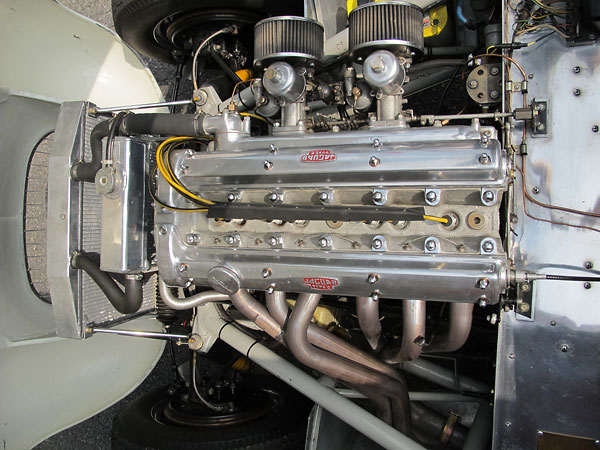
�
This replacement Jaguar engine is installed for vintage racing. Bob has the Hansgen Special's
�
actual original engine and transmission carefully stored away for future reinstallation.
�

�
This 3.5L engine has been prepared relatively conservatively.
�
Peak power is delivered at ~5700rpm. (No rev limiter is installed.)
�
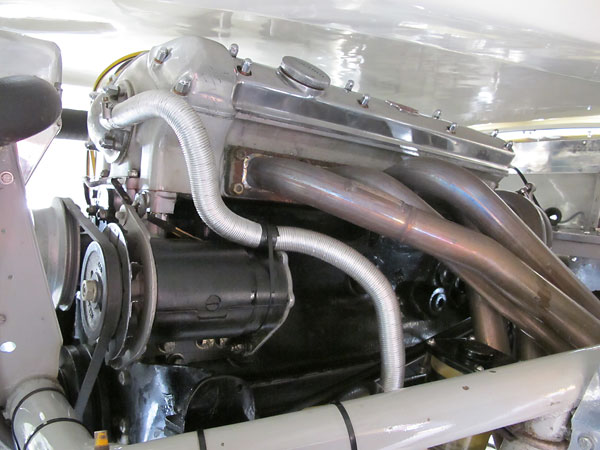
�
This photo illustrates that the engine has plenty of bonnet clearance.
�
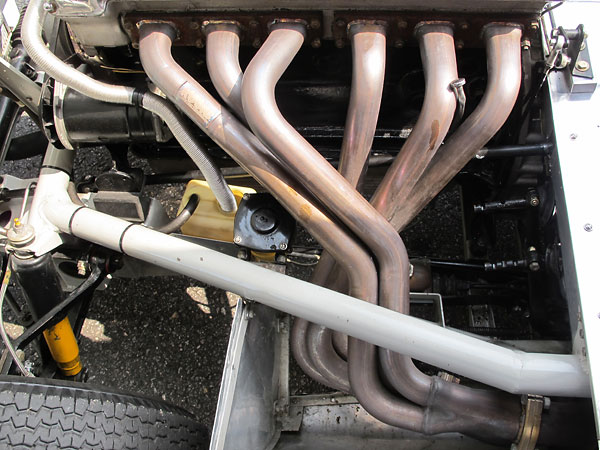
�
Six-two-one headers with such long primaries! The distance from the cylinder head to the
�
three-into-one collectors has been more than doubled compared to the car's original headers.
�
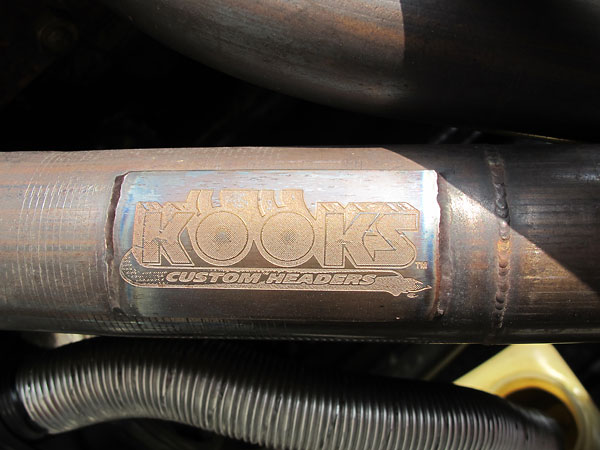
�
The custom-fabricated stainless steel exhaust was built by Kooks Custom Headers.
�
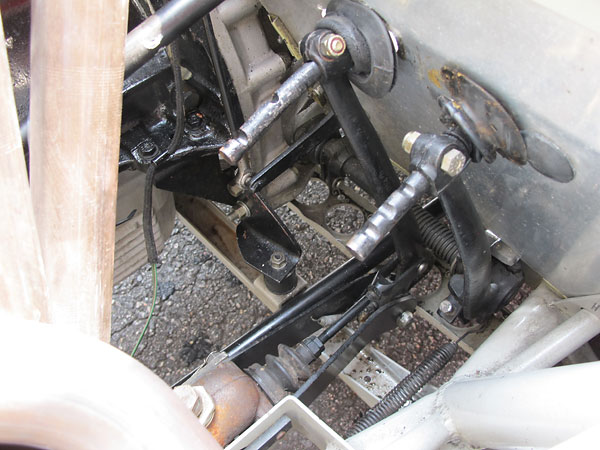
�
Adjustable brake and clutch pedals. Hansgen used an early XK120 master cylinder; later XK120s had
�
dual-circuit master cylinders. The clutch pedal operates directly, without cable or hydraulics.
�

�
Lucas generator.
�
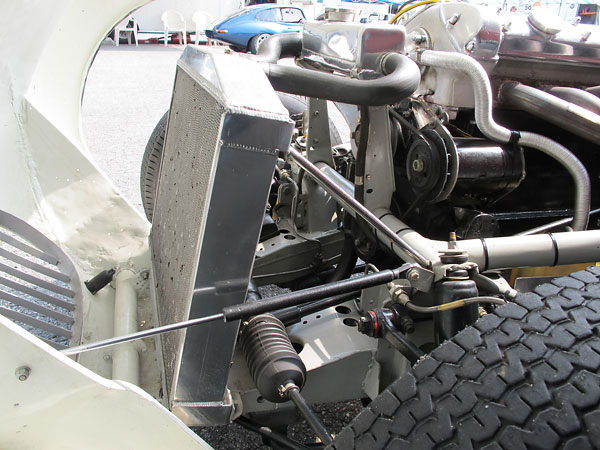
�
The custom aluminum radiator and matching header tank are two of very few modern components.
�
(Okay, the gas pressurized struts that make tilting the hood easier are also pretty conspicuous.)
�
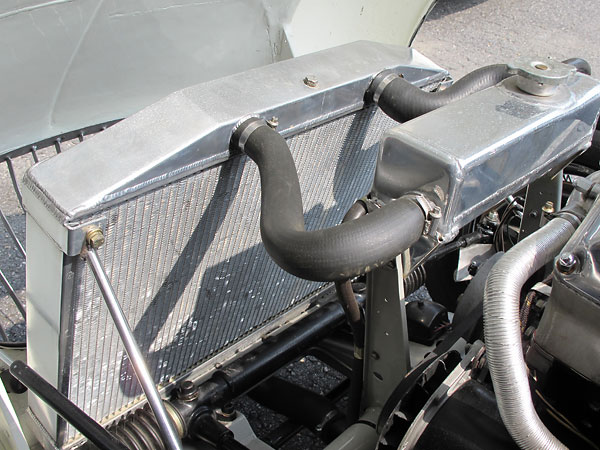
�
The header tank is the highest point in the cooling system.
�

�
Odyssey "yellow top" battery.
�
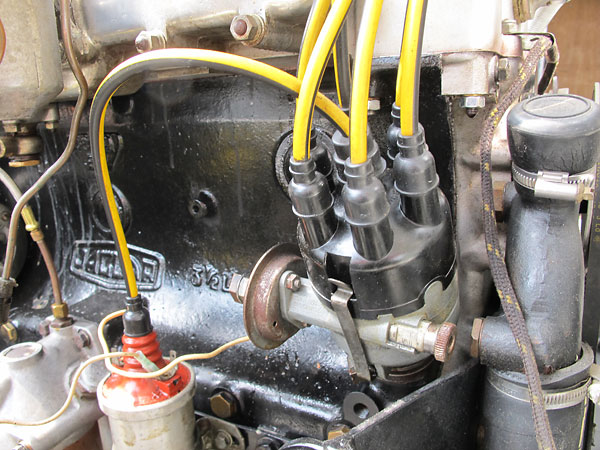
�
Lucas distributor, with old-fashioned breaker points inside.
�

�
Dual S.U. 1.75 inch bore (HD6) carburetors.
�
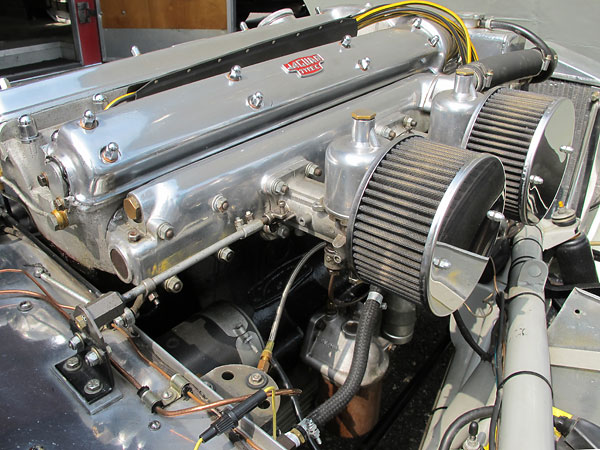
�
Throttle linkage detail.
�

�
The tachometer is driven by a cable connected to the exhaust-side camshaft.
�
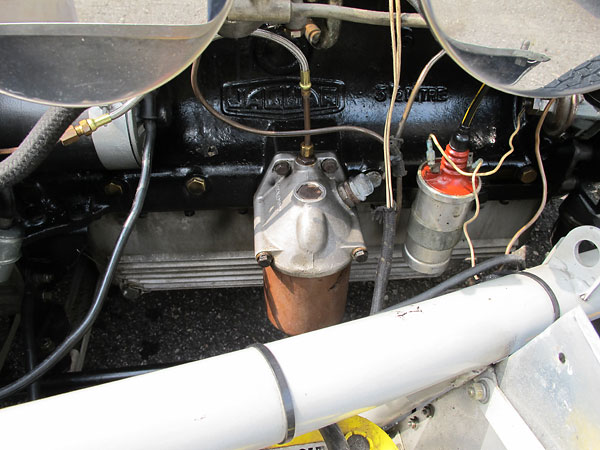
�
Oil filter. Note also finned aluminum oil pan, in background.
�
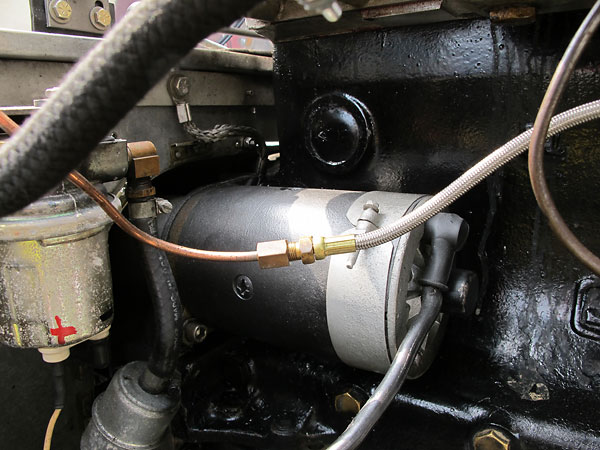
�
Lucas starter motor.
�
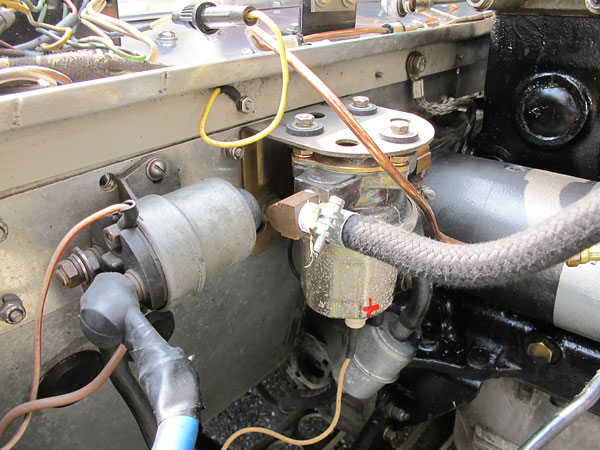
�
(right) Carter fuel pump. (left) Jaguar starter solenoid switch with integral pushbutton
�
for locally engaging the electric starter (which is handy when timing the engine, etc.)
�
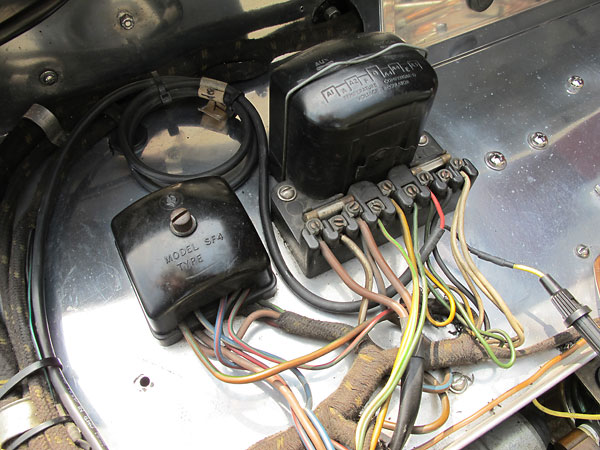
�
(left) Lucas "Model SF4 Type" four way fuse holder. (right) Lucas voltage regulator.
�
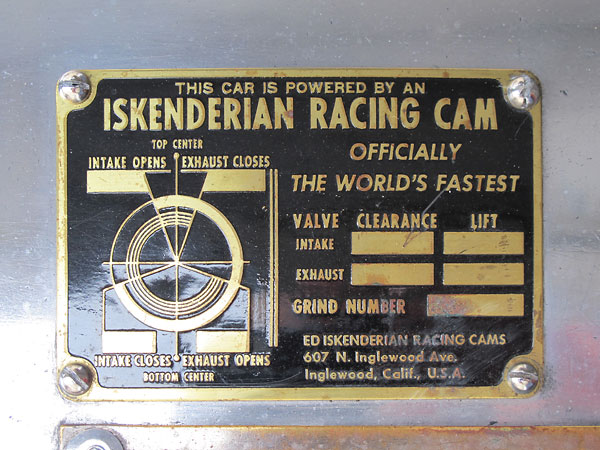
�
This car is powered by an ISKENDERIAN RACING CAM: officially the world's fastest!
�
Ed Iskenderian Racing Cams, 607 N. Inglewood Ave., Inglewood, Calif., U.S.A.
�
�
Front Suspension
��

�
A strong foundation! (Photograph courtesy of Bob Millstein.)
�

�
Springs, control arms, uprights, hubs, foundation brakes... all Jaguar XK120 parts.
�
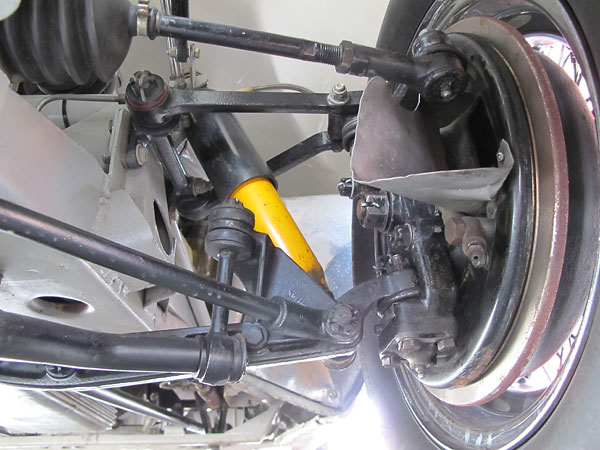
�
Hansgen used finned aluminum ("Alfin") brake drums, but Bob has removed and
�
carefully stored them for safe keeping. Instead, Bob races with iron drums.
�
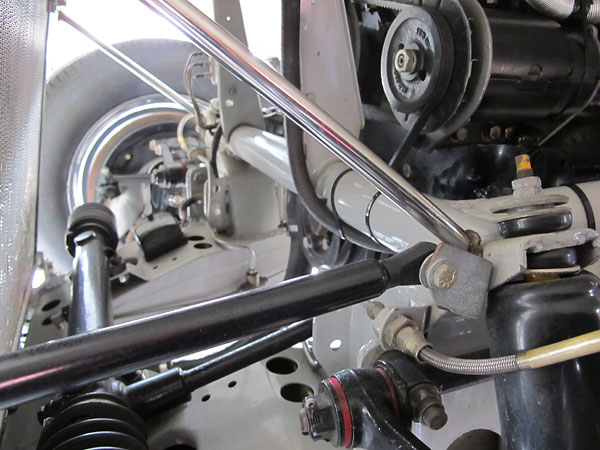
�
Hansgen used an MG TD steering rack instead of the Jaguar's original steering box.
�
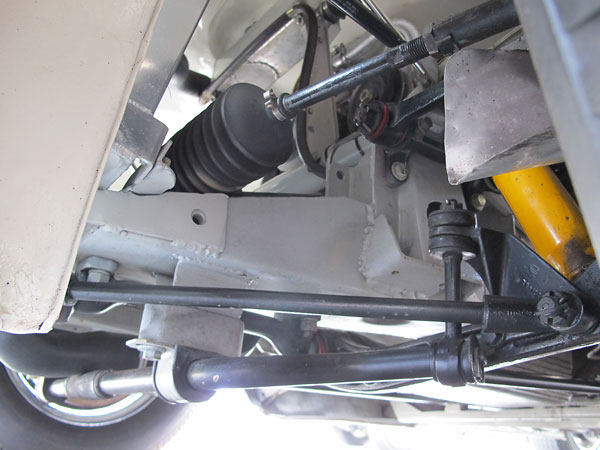
�
SPAX shock absorbers and red polyurethane bushes (in lieu of rubber) are minor changes.
�
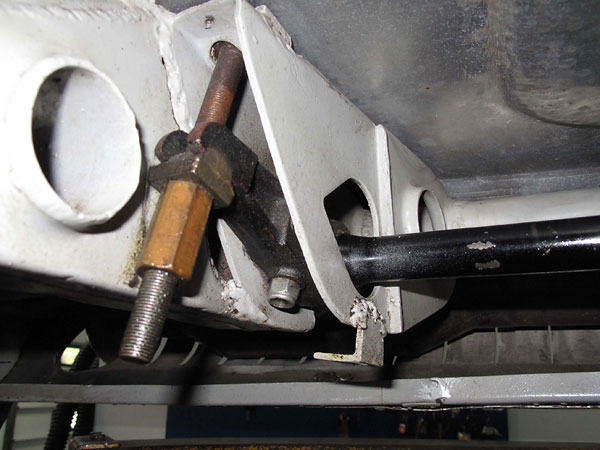
�
Attachment of driver's side torsion spring to a crossmember under the floorboard. Ride height
�
and corner-weight loading are adjusted by rotating the nut. The louvered exhaust cover in
�
background provides perspective: attachment is approximately on the same vertical plane
�
as the door hinges. (Photograph courtesy of Sean S. Smith Photography.)
�
�
Enjoying this article? www.BritishRaceCar.com is partially funded through generous support from readers like you!
�
To contribute to our operating budget, please click here and follow the instructions.
�
(Suggested contribution is twenty bucks per year. Feel free to give more!)�
Rear Suspension
��

�
Frame details, parking brake cable routing, and also the stainless steel muffler.
�
(Lime Rock Park has much stricter sound control requirements than other racetracks.)
�
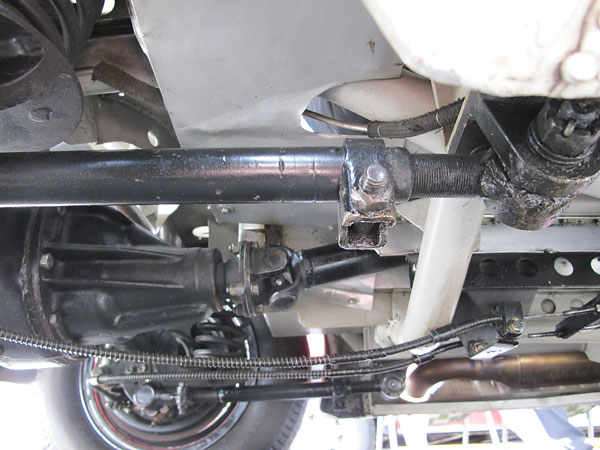
�
Adjustable trailing links.
�
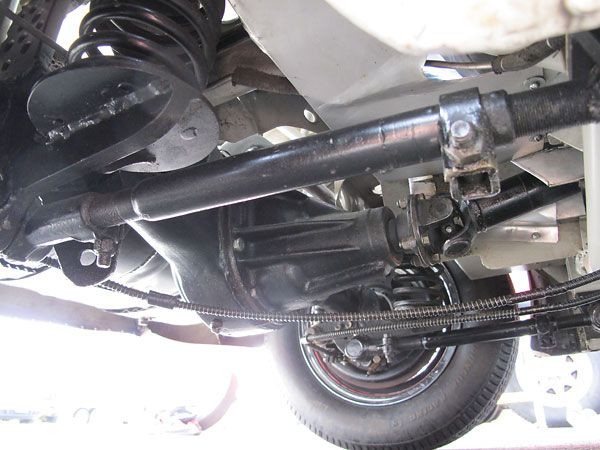
�
Hansgen installed coil springs and telescoping shocks where Jaguar had used leafsprings and
�
lever shock absorbers for the rear suspension of their XK120. The big difference is weight.
�
Across the whole project, he achieved an impressive weight reduction of over 500 pounds,
�
but most importantly he also achieved a significant reduction of unsprung weight too.
�
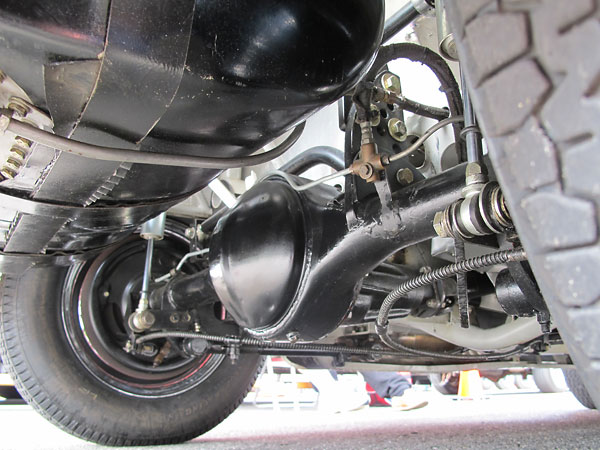
�
Three link rear suspension (e.g. two trailing links below the axle and one above) plus Panhard
�
bar. Interestingly, the upper trailing link is offset way over onto the righthand side.
�
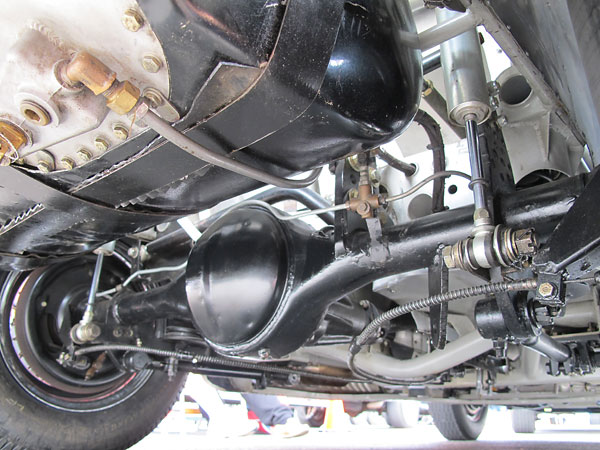
�
Pro Shocks telescoping shock absorbers.
�

�
Jaguar XK120 (ENV, not Salisbury) axle housing. Welded differential. 4.3:1 ring and pinion.
�
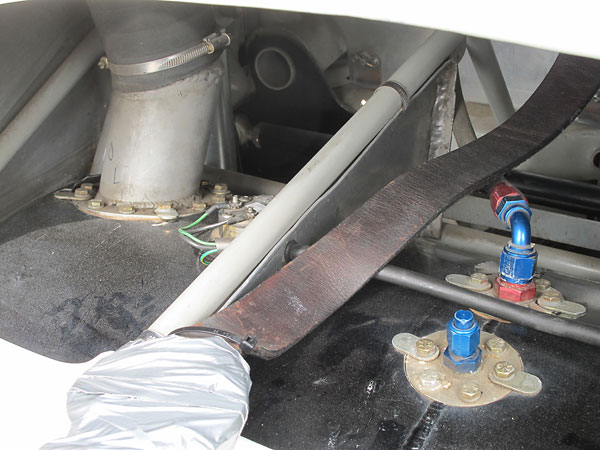
�
Original surplus aviation wing tank, with new rubber bladder installed inside.
�
�
Interior
� �
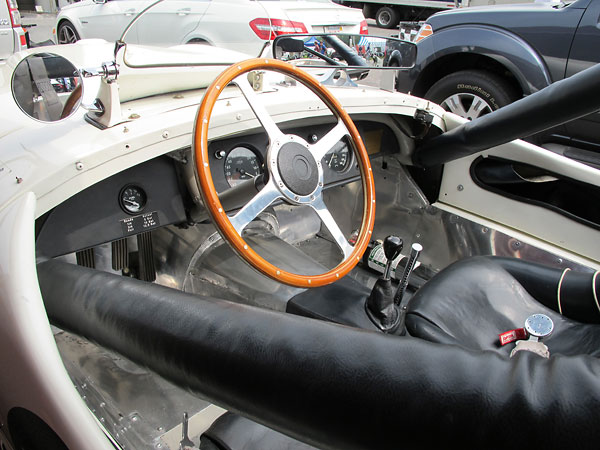
�
Climbing into the driver's seat requires stepping on the seat.
�
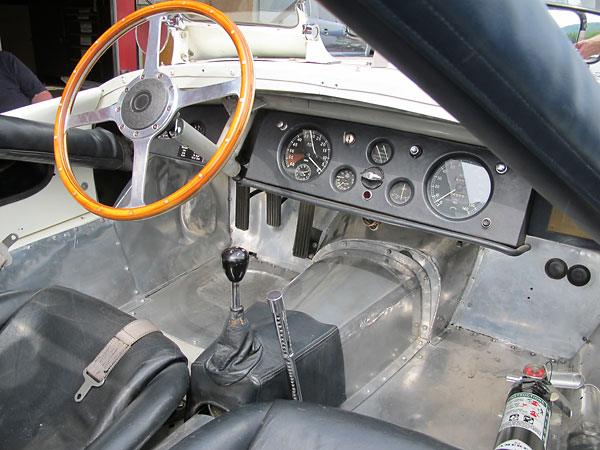
�
(left to right) Smiths gauges: tachometer (0-6000rpm counterclockwise, with integral clock at bottom),
�
dual oil pressure (0-100psi) and water temperature (30-90C) gauge, dual purpose petrol/oil level
�
(E-F, "Push switch for oil level."), ammeter (-30 to +30 amps), and speedometer (0-140mph).
�
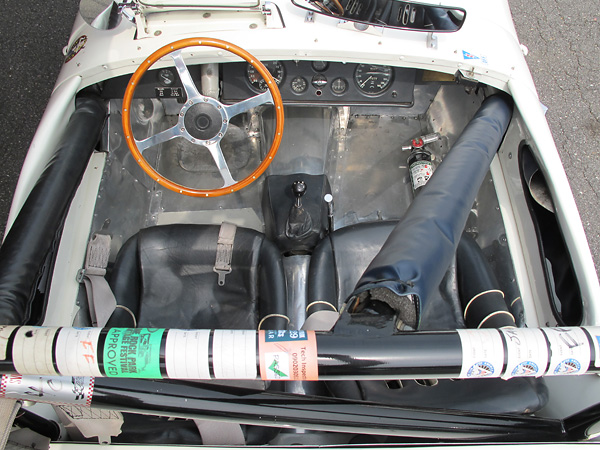
�
Aluminum paneled interior.
�
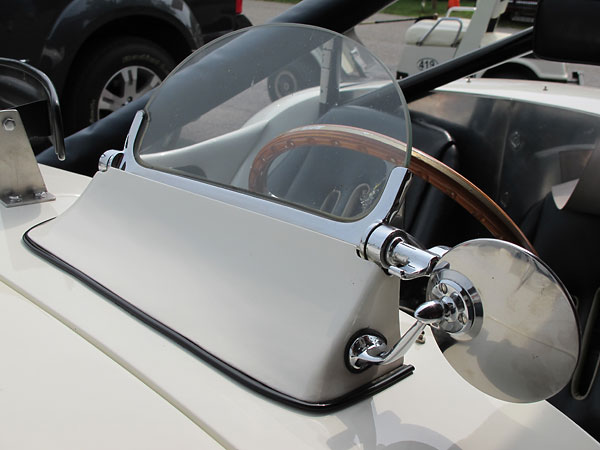
�
This is what's commonly called a Brooklands wind screen.
�
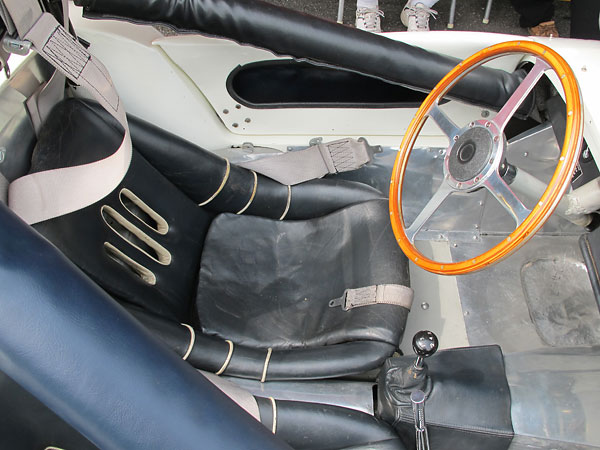
�
Hansgen is believed to have sourced these seats from a wrecked Siata.
�
(SIATA: Societa Italianà Applicazioni Techniche Automobilistiche.)
�
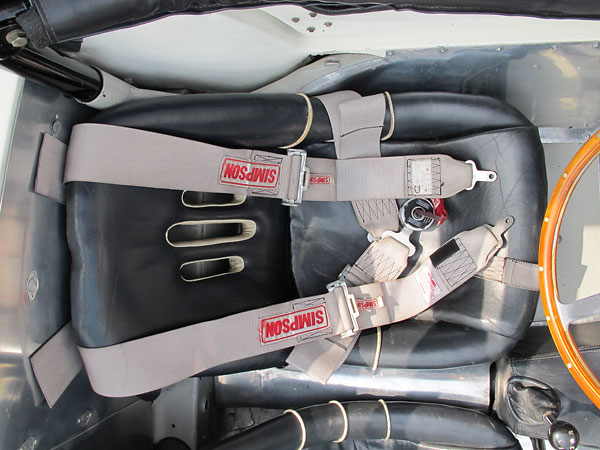
�
Simpson 5-point cam-loc safety harness.
�
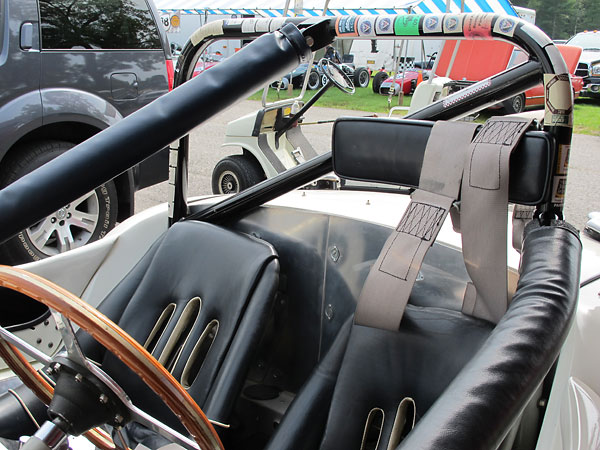
�
Headrest and roll hoop padding detail. Note Dzus fasteners on the cockpit's back wall.
�
The panel can be removed for convenient access to the rear suspension.
�
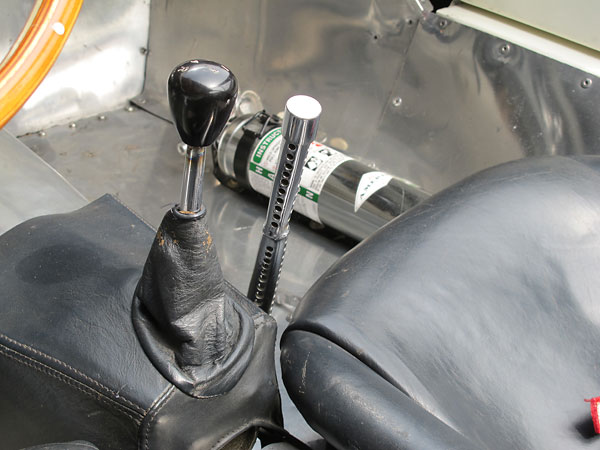
�
Gear selector. The knob is marked 1 through 4 in an H pattern, plus R down and to the right.
�

�
Footbox, pedal, floorboard, and transmission tunnel details.
�

�
Fuel Safe Racing Cells fuel gauge.
�
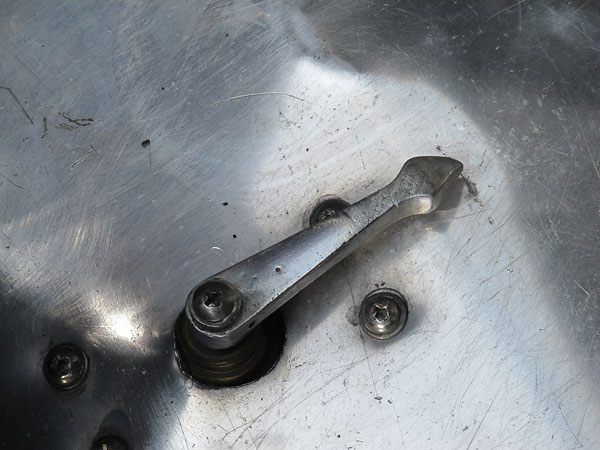
�
Fuel tank selection valve.
�
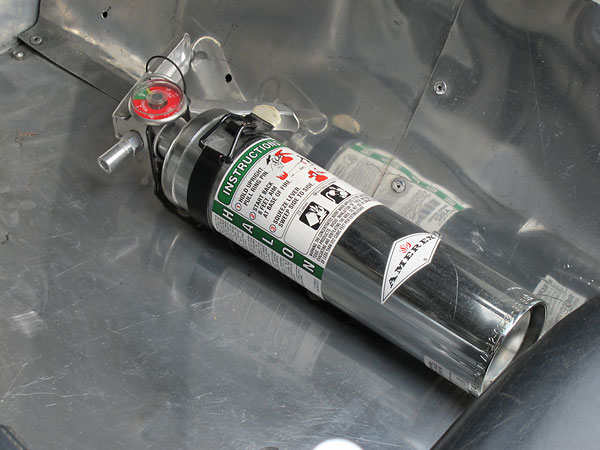
�
Amerex Halon fire extinguisher (hand held).
�
�
Exterior
��
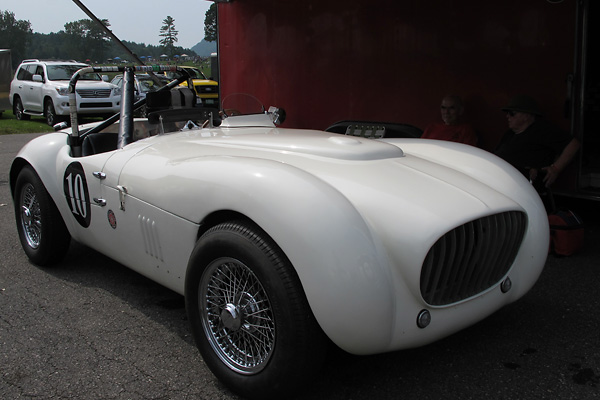
�
The Hansgen Special's original all-aluminum body was formed by German metal craftsmen who worked
�
in his family's automotive body shop in Westfield, New Jersey. Fabrication work was supervised
�
by Emil E. Hoffman, who welded together the thin aluminum panels with an oxygen-acetylene torch.
�
Hoffman had previously served in the U.S. Army Air Forces during WWII as a welding instructor.
�

�
The Hansgen Special's multi-tube frame is an elaborate three dimensional structure with good use
�
of triangulating braces forward of the doors and sheetmetal diaphragms in key areas further back.
�
It was an uncommonly efficient design for its era.
�
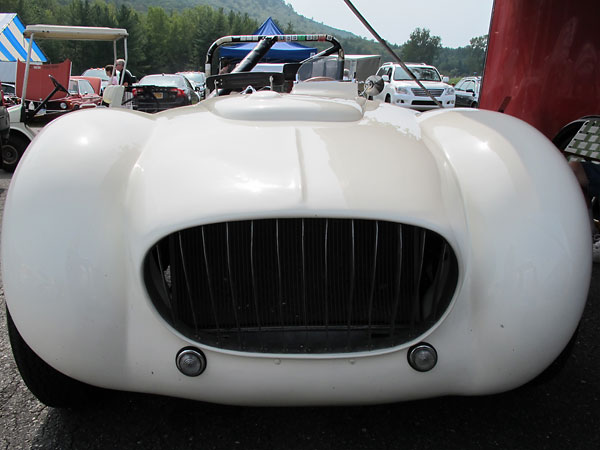
�
When first photographed in 1952: headlights were recessed into the radiator opening, a full-width two
�
piece flat-glass windscreen protected the driver, the muffler cover was bare aluminum, the seats were
�
upholstered with royal blue vinyl, and the car wore a black and orange 1952 New Jersey license plate.
�
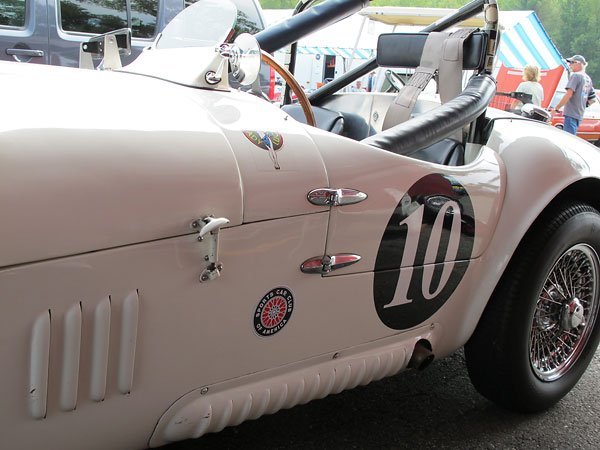
�
Trunk lid hinges from a Ford Sportsman woody convertible were used by Hansgen as door hinges.
�
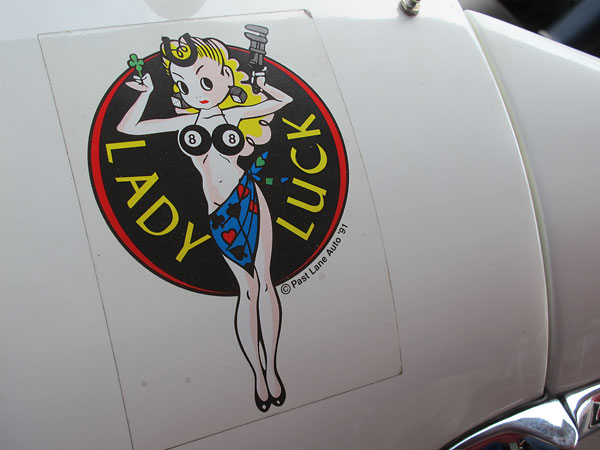
�
"Lady Luck" nose art. (Images like this graced the fuselages of WWII military airplanes.)
�
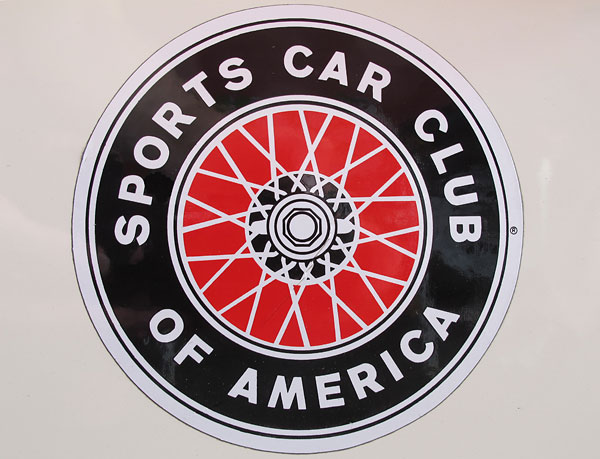
�
Sports Car Club of America decal. Walt Hansgen was a four-time SCCA National Champion. In Hansgen's era,
�
there was an unfortunate rivalry between SCCA and the United States Auto Club (USAC) which sanctioned
�
the Indianapolis 500 and other professional (mostly oval-track) races. Hansgen was an SCCA hero, but
�
he entered USAC races too. He piloted the MG Liquid Suspension Special in the 1964 Indianapolis 500.
�
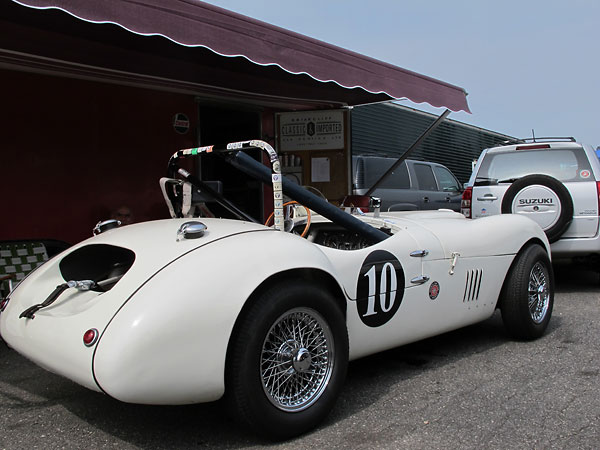
�
The roll hoop is entirely a bolt-in affair. It can be removed to
�
return the Hansgen Special to its original appearance.
�
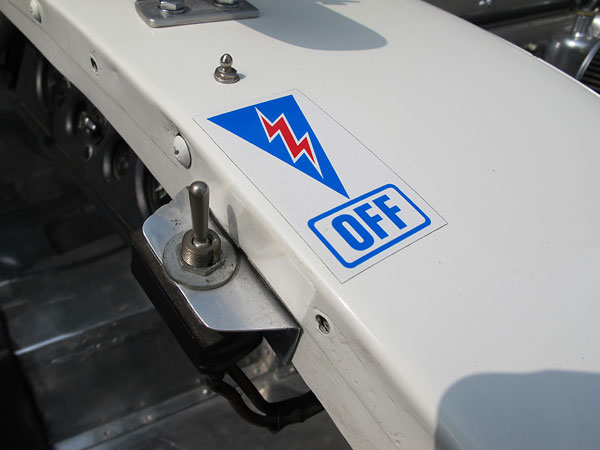
�
Kill switch.
�

�
Provisions for carrying a rear tire: recessed and partly exposed.
�
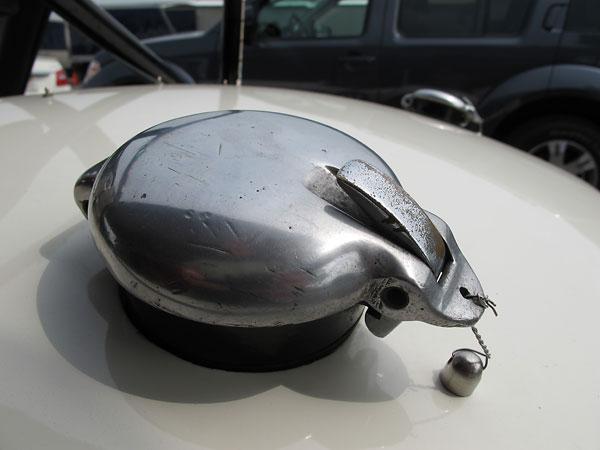
�
This style of fuel filler cap was used on Italian cars of the SIATA marque.
�

�
Dayton 72-spoke center laced wheels. (The original Borrani wire wheels are kept in safe storage.)
�
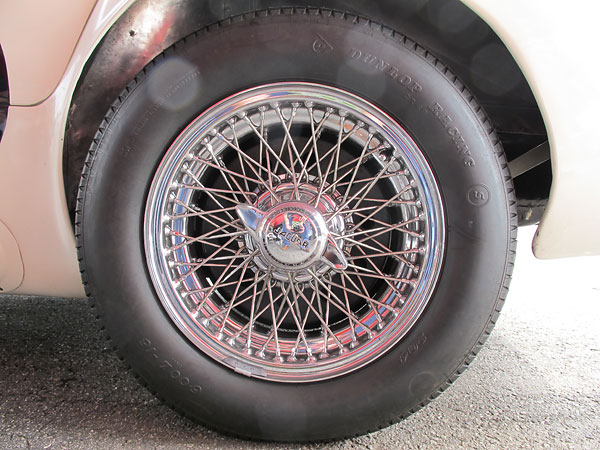
�
Dunlop Racing tires: 6.00L-16 size, CR-48 tread pattern, 204 (hard) compound.
�
| Notes: | |||||||
| (1) | �
Hansgen entered the twelve hour endurance race at Sebring but evidently made�
a last minute decision to drive Don McKnought's '52 Jaguar XK120 coupe instead�
of his own Jaguar Special. Actually, both cars are listed in the race program.�
The special is listed as a '51 XK120 roadster. As it turned out, due to�
mechanical problems the two drivers completed just 141 laps, vs. the 173 laps�
needed to keep up with Briggs Cunningham.�
� | ||||||
�
All photos shown here are from September 2011 when we viewed the car at Lime Rock Park in Connecticut.�
All photos by Curtis Jacobson for BritishRaceCar.com, copyright 2011.�
All rights reserved.�
�
| If you liked this article, you'll probably also enjoy these: | �|||||
 | �
Terry Buffum '50 Jaguar Special | �
 | �
Tivvy Shenton '55 Jaguar XK140 | �
 | �
Syd Silverman '59 Lister-Jaguar | �
| You're invited to discuss anything you've seen here on The British Racecar Motorsports Forum! | �|||||
�
Notice: all the articles and almost all the photos on BritishRacecar.com are by Curtis Jacobson.
�
(Photos that aren't by Curtis are explicitly credited.) Reproduction without prior written permission is prohibited.
�
Contact us to purchase images or reproduction permission. Higher resolution images are optionally available.
�

 �
�
